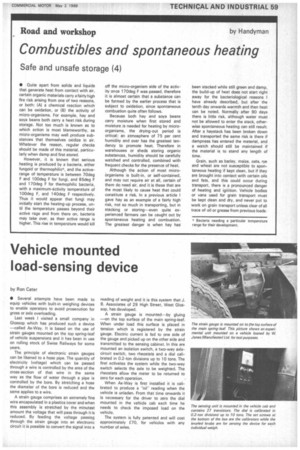Road and workshop by Handyman
Page 61

If you've noticed an error in this article please click here to report it so we can fix it.
Combustibles and spontaneous heating
Safe and unsafe storage (4)
• Quite apart from solids and liquids that generate heat from contact with air, certain organic materials carry a fairly high fire risk arising from one of two reasons, or both: (A) a chemical reaction which can be oxidation, or (B) the activity of micro-organisms. For example, hay and soya beans both carry a heat risk during storage. Not too much is known as to which action is most blameworthy, as micro-organisms may well .produce substances that themselves oxidize in air. Whatever the reason, regular checks should be made of this material, particularly when damp and first stored.
However, it is known that serious heating is produced by a bacteria, either fungoid or thermophilie, and the activerange of temperature is between 70deg F and 100deg F for fungi, and 85deg F and 170deg F for themophilic bacteria, with a maximum-activity temperature of 100deg F, and 140deg F respectively. Thus it would appear that fungi may initially start the heating-up process, until the temperature passes beyond their active rage and from there on, bacteria may take over, as their active range is higher. This rise in temperature would kill off the micro-organism side of the activity once 170deg F was passed, therefore it is almost certain that a substance can be formed by the earlier process that is subject to oxidation, since spontaneous combustion quite often follows.
Because both hay and soya beans carry moisture when first stored and moisture is needed for heating by microorganisms, the drying-out period is critical; an atmosphere of 75 per cent humidity and over has the greatest tendency to promote heat. Therefore in warehouses or sheds storing organic substances, humidity should be carefully watched and controlled, combined with frequent checks for the presence of heat.
Although the action of most microorganisms is built-in, or self-contained, and may not require air at all, certain of them do need air, and it is these that are the most likely to cause heat that could constitute a risk. In a previous article I gave hay as an example of a fairly high risk, not so much in transporting, but in stacking or storing—even quite experienced farmers can be caught out by spontaneous heating and combustion. The greatest danger is when hay has been stacked while still green and damp, the build-up of heat does not start right away for the bacteriological reasons I have already described, but after the tenth day onwards warmth and then heat can be noted. Normally after 90 days there is little risk, although water must not be allowed to enter the stack, otherwise spontaneous heating can still result. After a haystack has been broken down and transported the same risk is there if dampness has entered the material, and a watch should still be maintained if the material is to stand any length of time.
Grain, such as barley. maize, oats, rye and wheat are not susceptible to spontaneous heating if kept clean, but if they are brought into contact with certain oils and fats, and this could occur during transport, there is a pronounced danger of heating and ignition. Vehicle bodies or vans used for grain transport must be kept clean and dry, and never put to work on grain transport unless clear of all trace of oil or grease from previous loads.




















































































































































































































